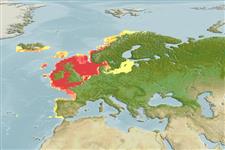Classification / Names
Common names from other countries
Main reference
Size / Weight / Age
Max length : 130 cm TL male/unsexed; (Ref. 1371); common length : 75.0 cm TL male/unsexed; (Ref. 1371); max. published weight: 18.1 kg (Ref. 40637); max. reported age: 8 years (Ref. 1371)
Length at first maturity
Lm 41.0, range 42 - ? cm
Environment
Marine; benthopelagic; oceanodromous (Ref. 51243); depth range 40 - 200 m (Ref. 6302), usually 40 - 100 m (Ref. 54707)
Climate / Range
Temperate, preferred 9°C (Ref. 107945); 72°N - 36°N, 25°W - 28°E
Distribution
Northeast Atlantic: Iceland, the Faeroes and Norway to the Bay of Biscay (Ref. 1371); also southern Baltic Sea (Ref. 89342) with records from Poland, Latvia and Estonia (Refs. 36252, 52079).
Countries | FAO areas | Ecosystems | Occurrences | Introductions
Short description
Dorsal
spines
(total): 0;
Dorsal
soft rays
(total): 29-33;
Anal
soft rays: 27 - 30;
Vertebrae: 52 - 55. Lower jaw distinctly projecting beyond upper ones. Lacks a chin barbel. Dark lateral line that sharply curves over the pectoral fin and continues over whole body. No dark spot at pectoral fin base. Dorsal and anal fin interspaces short. Sensory canals with large pores on head. Body color is variable; dark dorsally, sharply distinguished from silver-gray sides and belly; the upper part of the body with yellow to orange streaks or blotches; the lateral line greenish. The fins uniformly dark except for the pelvic fins which are yellowish.
IUCN Red List Status (Ref. 115185)
Threat to humans
Harmless
Human uses
Fisheries: commercial; gamefish: yes
Tools
Special reports
Download XML
Internet sources
Estimates of some properties based on models
Phylogenetic diversity index
PD50 = 0.7500 many relatives (e.g. carps) 0.5 - 2.0 few relatives (e.g. lungfishes)
Trophic Level
4.3 ±0.3 se; Based on diet studies.
Resilience
Medium, minimum population doubling time 1.4 - 4.4 years (K=0.19; tmax=8)
Vulnerability
High vulnerability (59 of 100)
Price category
